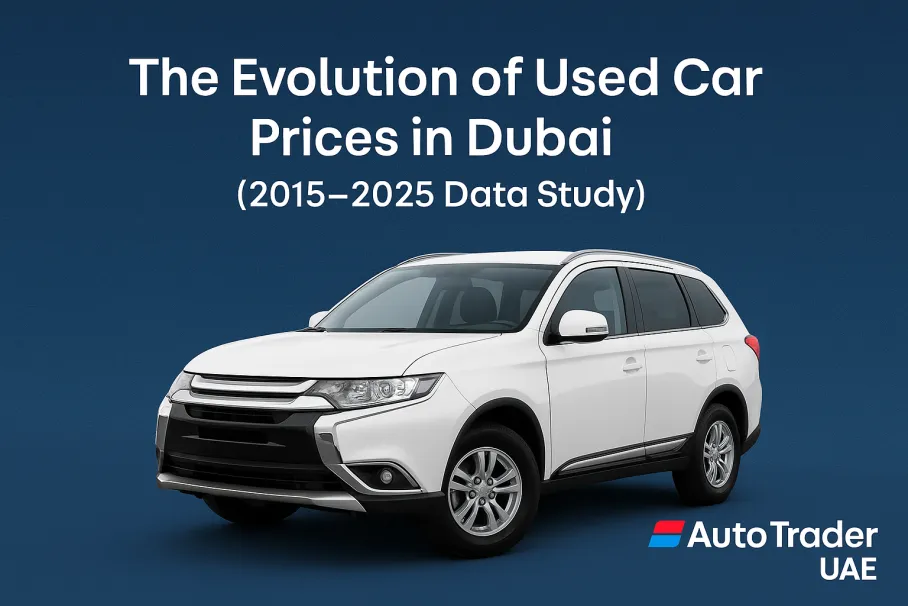The Evolution of Used Car Prices in Dubai (2015–2025 Data Study)
Executive Summary
Between 2015 and 2025, Dubai’s used car market experienced a decade of dramatic transformation — from stable post-2015 pricing to pandemic-era inflation and, finally, a market correction after 2023. This data-driven analysis explains how global supply chains, economic shifts, and local buyer trends shaped used car prices in Dubai over ten years.
Methodology & Data Sources
Period Covered: 2015–2025
Sources: Market data from AutoData Middle East, the UAE’s official CPI/transportation index, Reuters Dubai Economy Coverage, and aggregated listings from Auto Trader UAE, Dubizzle, and DubiCars.
Approach: A comparative analysis of average listed prices, residual-value reports, and macroeconomic conditions.
Year-by-Year Timeline of Used Car Prices in Dubai
|
Year
|
Used Car Price Index (2015 = 100)
|
Market Trend Summary
|
|
2015
|
100
|
Stable, post-oil price normalization
|
|
2016
|
98
|
Slight decline due to strong AED and ample supply
|
|
2017
|
97
|
Competitive pricing as inventory grew
|
|
2018
|
99
|
Minor rebound; healthy demand for SUVs
|
|
2019
|
102
|
Market stabilizing before global disruption
|
|
2020
|
110
|
COVID-19 supply chain shock; new car delays
|
|
2021
|
128
|
Global shortage; sharp rise in used car prices
|
|
2022
|
136
|
Price peak; minimal inventory
|
|
2023
|
122
|
Market correction begins
|
|
2024
|
113
|
Prices drop with new car availability
|
|
2025
|
108
|
Return to pre-pandemic pricing patterns
|
Chart: Evolution of Used Car Prices in Dubai (2015–2025)
Source: Auto Trader UAE analysis, AutoData, UAE CPI Transport Index (2015–2025)

2015–2018: Stability Returns After Economic Adjustment
After the oil price turbulence of the early 2010s, Dubai’s used car market found balance. Ample supply from corporate fleets and expatriate turnover kept prices stable. SUVs and mid-size sedans dominated listings on Auto Trader UAE, reflecting consistent buyer preference.
2019–2020: Early Disruptions and Pandemic Shock
By late 2019, the first hints of disruption appeared. COVID-19 restrictions and semiconductor shortages caused new car inventory delays. Dubai residents began turning to pre-owned vehicles, raising prices slightly.
2021–2022: Record High Prices
This period marked the peak of the decade for used car values. Supply bottlenecks pushed used vehicle prices to record highs.
According to TIME and Reuters, global shortages elevated used car prices worldwide — and Dubai was no exception.
Luxury cars, pickup trucks, and reliable Japanese brands all saw 25–35% jumps in resale value. Auto Trader UAE listings showed reduced inventory as demand surged beyond supply.
2023–2025: Correction and Market Realignment
With new-car production recovering, Dubai’s market began to normalize.
Average used-car prices fell steadily — a trend analyzed in our internal reports:
Segment-specific shifts became evident:
- Luxury & EVs: largest drop as more supply returned.
- Japanese SUVs: held their value best due to reliability and high resale demand.
- Fleet cars: steady depreciation, high availability.
What’s Driving These Changes?
- Global Supply Chain Shocks (2020–2022)
Semiconductor and shipping crises led to historically low new car availability, forcing buyers into the used market.
- Inventory Recovery (2023–2025)
Automakers increased production, restoring showroom inventory and cooling used car prices.
- Local Demand Factors
Economic growth, population mobility, and visa reforms influenced demand cycles. A growing population in Dubai fueled a healthy used car ecosystem, but rising living costs encouraged buyers to seek affordable pre-owned options.
- Segment Volatility
EVs and high-end models saw sharper depreciation, while mid-tier SUVs remained stable — a sign that value-based consumer behavior dominates post-2023.
What This Means for Buyers and Sellers in Dubai
For Buyers:
2025 offers one of the best opportunities in years to buy quality used cars at competitive prices. Certified pre-owned programs and flexible financing add extra value.
For Sellers:
Longer selling times are expected. To attract buyers, ensure full service history, high-quality photos, and competitive pricing.
For Dealers:
Inventory optimization and transparent online listings are essential in 2025’s competitive landscape.
Research Takeaway
Over ten years, used car prices in Dubai moved through a clear cycle — stability, inflation, and correction.
The 2025 market now represents a return to value, with prices roughly 8% above the 2015 baseline — but 20% below their 2022 peak.
Final Paragraph
Dubai’s used car market continues to evolve, balancing affordability and demand after a decade of change. Whether you’re buying or selling, Auto Trader UAE remains the top destination for used cars in Dubai, featuring trusted dealers, verified listings, and the latest market insights. Explore more at www.autotraders.ae.

